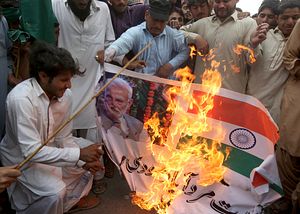Recent tensions between India and Pakistan over Kashmir have boiled into a full-blown military crisis in the region. The crisis started when a suicide bomber attacked Indian forces in the Pulwama district of Kashmir, killing over 40 Indian soldiers. The attack was claimed by the Pakistan-based Jaish-e-Mohammed (JeM) group, though Pakistan was quick to deny any involvement. Since then, Pakistan and India have exchanged a series of tit-for-tat military operations, including India’s incursion into Pakistani airspace to target a JeM training camp, leading to Pakistan shooting down two Indian jets.
Analysts have been largely examining the crisis from the perspective of India and Pakistan’s nuclear rivalry and the consequences for escalation while ignoring the broader nationalist forces at play. It is easy to depict the unfolding crisis as almost a series of self-contained events — a perfect depiction of deterrence theory. But the evolution of the crisis goes beyond military and strategic significance to implicate the future of South Asian society. The current crisis presents an opportunity for both Indian and Pakistani leadership to shore up their nationalist vision for South Asia.
In recent years, the rise of Prime Minister Narendra Modi and Hindu nationalism have slowly eroded the idea that India represents a home for multiple ethnicities, religious groups, and classes. And Pakistan’s continuing practice of oppressing religious minorities finds acceptance and legitimacy in the leadership of Imran Khan. Of course, both of these trends have a longer history — both India’s multicultural identity and Pakistan’s Islamic identity have been fraught since their partition in 1947.
But recent societal trends in India reveal growing communal violence — particularly by emboldened far-right Hindu nationalists targeting the Muslim populace. Some of this violence targets Muslims who eat beef, or are even simply accused of eating beef, resulting in the bizarre moniker “cow-terrorism.” To be sure, these sorts of attacks have also been perpetrated on left-leaning Hindu journalists in India, indicating that the rise of India’s far right poses a danger to many Indians despite their personal religious beliefs. What’s more, there are explicit attempts to rewrite India’s rich and complex history — a history that has political and social origins in both Hindu and Muslim rule — to downplay the history of Islam on the subcontinent.
And on the other side, the election of Pakistani Prime Minister Imran Khan has only reinforced the pre-existing nationalist tendencies of the Pakistani establishment, which has often legitimized its rule through the Indian threat. Khan’s ability to triangulate Islam, the Pakistan Army, and a strong nationalist Pakistani identity has made him a popular leader in Pakistan. But his defense of Pakistan’s blasphemy laws further alienates and oppresses the few minority groups that remain in Pakistan.
What do all of these trends have to do with the current crisis? Nationalist enmity is a constant throughout India and Pakistan’s post-partition history but the specific ways in which Modi and Khan consolidate national identity in their respective contexts drives the responses. The Modi government has blamed the media for highlighting the rise of hate crimes in India but it has actually been quite effective in bringing a variety of religious leadership in line with its nationalist views. Since the current crisis began, Hindu, Muslim, and Christian leadership in India have used their platform and religious authority to adopt anti-Pakistan rhetoric and to promote a swift and potentially violent response. Even Bollywood celebrities are getting in on nationalist fervor. And on the Pakistani side, prominent politicians purport that India is in a “war frenzy” and that India’s claim of striking a terrorist camp is a hoax.
An inordinate focus on strategic dimensions of the crisis leads to a kind of military myopia, which limits our ability to see this crisis on a grander scale. It is also in part why the events of the last few days are a “crisis” while the growth in ideological polarization is not identified in the same way. In the aftermath of the crisis, observers should continue to pay close attention to how the incident will affect the ability of Indian and Pakistani leadership to use the events in legitimating their nationalist policies.
As a scholar of nuclear politics, it is easy to take the rivalry between India and Pakistan for granted and even to see it as a natural part of either regional power politics or the enmity between Hindus and Muslims. But the rivalry endures because of specific policies and practices that continue to link domestic governance with the threat of the other. And right now, these nationalist policies are being bolstered through the crisis. Rather than falling into the trap of only contemplating the strategic dimensions of the crisis, consider what it means for South Asian society as a whole — not for a separate Pakistan and a separate India.
Sidra Hamidi is a Stanton Nuclear Security Postdoctoral Fellow at the Center for International Security and Cooperation (CISAC) at Stanford University.

































